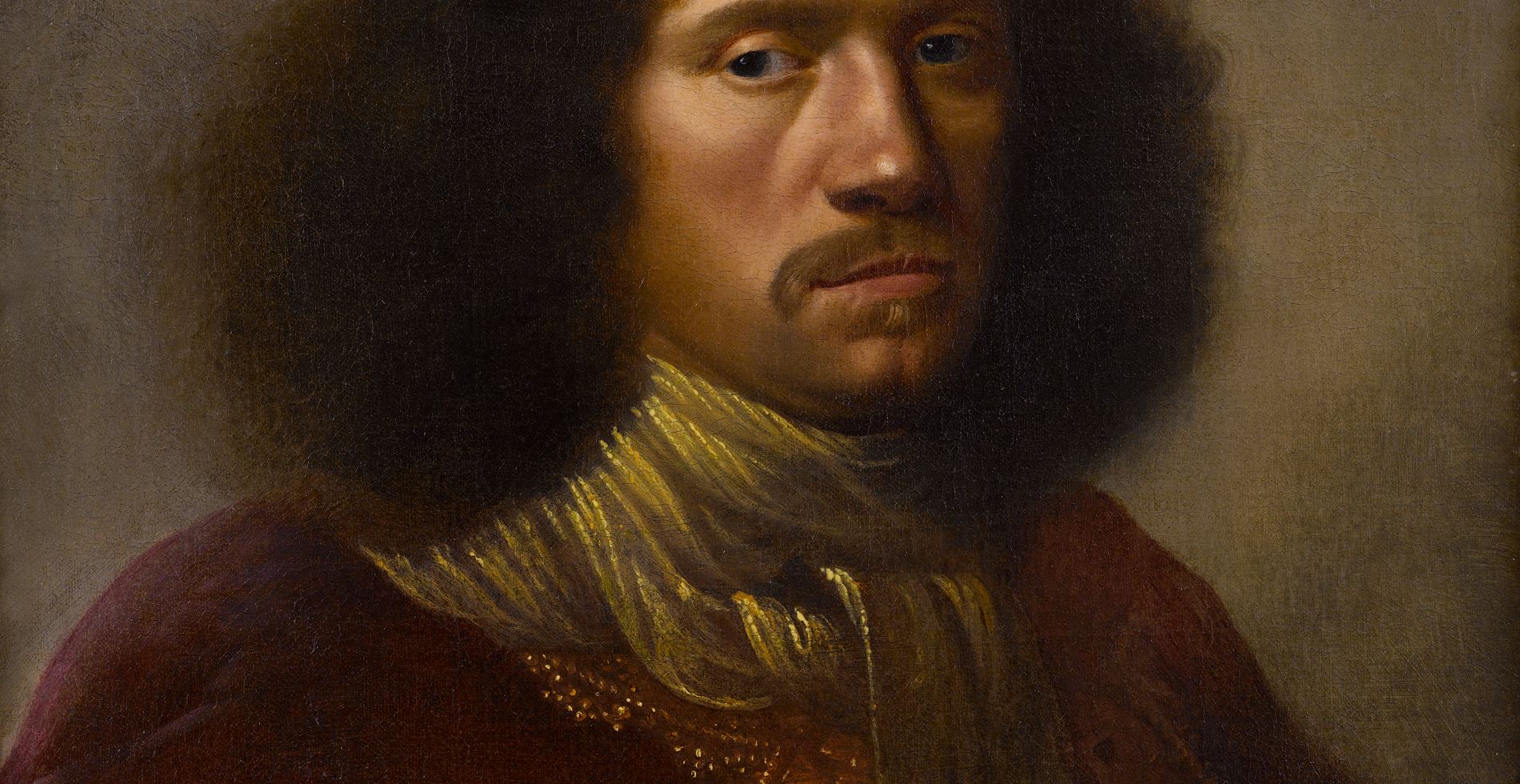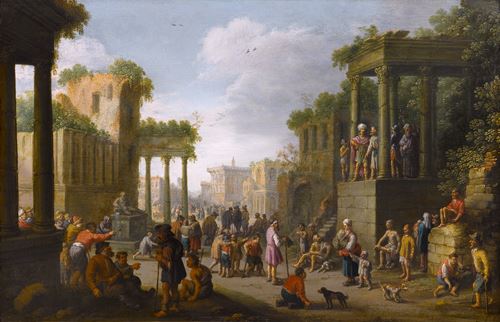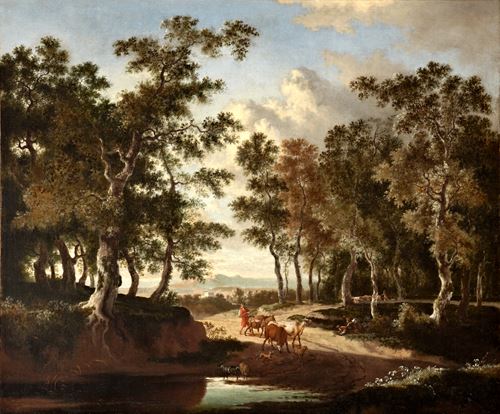aniël de Koninck
(Amsterdam 1668 - England 1720)
Portrait of a Man, Half-Length, Wearing a Plumed Turban and Gold Embroidered Red Cloak with a White Shawl
oil on canvas
64.5 x 51.5 cm (25¼ x 20¼ in)
This striking portrait, attributed to Daniël de Koninck, exemplifies the seventeenth-century fashion for romanticising sitters by depicting them in eastern dress. The costume detail is very fine and rich, giving the man a theatrical air, while his face, pierced by soulful eyes, is depicted with great realism. He wears a large ostentatious turban that sparkles in the light with a feather pinned by a jewelled broach. The sheen of the headdress is matched by a white scarf wrapped around his neck. His red cloak is embroidered in gold, and two strands of jewels adorn his chest. The ensemble is not one that would be worn every day, and gives the impression of a studio costume.
Depictions of gentlemen dressed in exotic finery with turbans evidently made up a significant portion of de Koninck’s oeuvre with several existing paintings by him that are similar to the present attributed work. Portrait of a Man Wearing a Plumed Turban, portrays a more mature gentleman wearing an equally prominent turban with a feather and a scarf wrapped around his neck in similar fashion to the present sitter. His sombre expression and the plain background against which he is posed, like in the present painting, is in contrast to the frivolity and opulence of his dress.
In his ‘orientalised’ portraits, de Koninck appears to take inspiration from Rembrandt, who devoted much of his production to tronies, depictions of single figures in historical, oriental or imaginary costumes. These were more of an opportunity for the artist to demonstrate his skill in representing exotic garments, facial types and lighting effects, than conventional portraits. Rembrandt’s A Young Man Wearing a Turban in the Royal Collection, depicts the sitter wearing a modest turban, less flamboyant than the ones discussed thus far, but otherwise the painting is striking in its similarity in composition and style to the present work. The sitter is painted bust-length, turned to the right, and wears a lustrous darkly coloured turban and gown and a long jewelled chain around his neck, clearly setting the precedent that de Koninck would follow. It has been suggested that Philips Koninck, Daniël’s uncle, may have been one of Rembrandt’s pupils, a connection that could have also influenced Daniël.
The de Konincks were a Dutch family of painters, draughtsmen and printmakers spanning several generations, although the relationships between the individual family members are unclear. Little is known about Daniël de Koninck’s life except that he studied under another uncle, Jacob de Koninck (c. 1612-1690), from 3 September 1682. A record states that on 3 August 1690, Daniël paid off his apprenticeship fee ‘to my Uncle Jacob de Koninck, Painter in Copenhagen’. Soon after, he moved to Oxford and by 1720 was living in London, where it seems he built a considerable reputation as a portrait painter.
In the family of the previous owner since at least 1910.
This striking portrait, attributed to Daniël de Koninck, exemplifies the seventeenth-century fashion for romanticising sitters by depicting them in eastern dress. The costume detail is very fine and rich, giving the man a theatrical air, while his face, pierced by soulful eyes, is depicted with great realism. He wears a large ostentatious turban that sparkles in the light with a feather pinned by a jewelled broach. The sheen of the headdress is matched by a white scarf wrapped around his neck. His red cloak is embroidered in gold, and two strands of jewels adorn his chest. The ensemble is not one that would be worn every day, and gives the impression of a studio costume.
Depictions of gentlemen dressed in exotic finery with turbans evidently made up a significant portion of de Koninck’s oeuvre with several existing paintings by him that are similar to the present attributed work. Portrait of a Man Wearing a Plumed Turban, portrays a more mature gentleman wearing an equally prominent turban with a feather and a scarf wrapped around his neck in similar fashion to the present sitter. His sombre expression and the plain background against which he is posed, like in the present painting, is in contrast to the frivolity and opulence of his dress.
In his ‘orientalised’ portraits, de Koninck appears to take inspiration from Rembrandt, who devoted much of his production to tronies, depictions of single figures in historical, oriental or imaginary costumes. These were more of an opportunity for the artist to demonstrate his skill in representing exotic garments, facial types and lighting effects, than conventional portraits. Rembrandt’s A Young Man Wearing a Turban in the Royal Collection, depicts the sitter wearing a modest turban, less flamboyant than the ones discussed thus far, but otherwise the painting is striking in its similarity in composition and style to the present work. The sitter is painted bust-length, turned to the right, and wears a lustrous darkly coloured turban and gown and a long jewelled chain around his neck, clearly setting the precedent that de Koninck would follow. It has been suggested that Philips Koninck, Daniël’s uncle, may have been one of Rembrandt’s pupils, a connection that could have also influenced Daniël.
The de Konincks were a Dutch family of painters, draughtsmen and printmakers spanning several generations, although the relationships between the individual family members are unclear. Little is known about Daniël de Koninck’s life except that he studied under another uncle, Jacob de Koninck (c. 1612-1690), from 3 September 1682. A record states that on 3 August 1690, Daniël paid off his apprenticeship fee ‘to my Uncle Jacob de Koninck, Painter in Copenhagen’. Soon after, he moved to Oxford and by 1720 was living in London, where it seems he built a considerable reputation as a portrait painter.
In the family of the previous owner since at least 1910.





 contact
contact +44 20 7313 8040
+44 20 7313 8040









